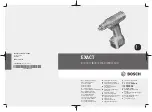
6
ENGLISH
(Original instructions)
7
ENGLISH
(Original instructions)
Damage to the chuck and personal injury may occur when
changing accessories in this manner.
Use
Warning!
Let the tool work at its own pace. Do not overload.
Charging the battery (fig. A)
The battery needs to be charged before first use and whenev-
er it fails to produce sufficient power on jobs that were easily
done before. The battery may become warm while charging;
this is normal and does not indicate a problem.
Warning!
Do not charge the battery at ambient temperatures
below 10 °C or above 40 °C. Recommended charging tem-
perature: approx. 24 °C.
Note: The charger will not charge a battery if the cell
temperature is below approximately 10 °C or above 40 °C.
The battery should be left in the charger and the charger
will begin to charge automatically when the cell tempera-
ture warms up or cools down.
u
To charge the battery (5), insert it into the charger (8).
The battery will only fit into the charger in one way. Do
not force. Be sure that the battery is fully seated in the
charger.
u
Plug in the charger and switch on at the mains.
The charging indicator (9) will flash green continuously
(slowly).
The charge is complete when the charging indicator (9) lights
green continuously. The charger and the battery can be left
connected indefinitely with the LED illuminated. The LED will
change to flashing green (charging) state as the charger occa-
sionally tops up the battery charge. The charging indicator (9)
will be lit as long as the battery is connected to the plugged-in
charger.
u
Charge discharged batteries within 1 week. Battery life will
be greatly diminished if stored in a discharged state.
Leaving the battery in the charger
The charger and battery pack can be left connected with the
LED glowing indefinitely. The charger will keep the battery
pack fresh and fully charged.
Charger diagnostics
If the charger detects a weak or damaged battery, the
charging indicator (9) will flash red at a fast rate. Proceed as
follows:
u
Re-insert the battery (5).
u
If the charging indicators continues flashing red at a fast
rate, use a different battery to determine if the charging
process works properly.
u
If the replaced battery charges correctly, the original
battery is defective and should be returned to a service
centre for recycling.
u
If the new battery gives the same indication as the original
battery, take the charger to be tested at an authorised
service centre.
Note: It may take as long as 60 minutes to determine that
the battery is defective. If the battery is too hot or too
cold, the LED will alternately blink red, fast and slow, one
flash at each speed and repeat.
Selecting the direction of rotation (fig. C)
For tightening, use forward (clockwise) rotation. For loosening,
use reverse (counterclockwise) rotation.
u
To select forward rotation, push the forward/reverse slider
(2) to the left.
u
To select reverse rotation, push the forward/reverse slider
to the right.
u
To lock the tool, set the forward/reverse slider into the
centre position.
Selecting the torque (fig. E)
This tool is fitted with a collar to set the torque for various
screwdriving and drilling applications. Large screws and hard
workpiece materials require a higher torque setting than small
screws and soft workpiece materials. For the definition of the
symbol refer to the listing below
u
For drilling in wood, metal and plastics, set the torque
adjustment collar (4) to the
b
symbol.
u
For screwdriving, set the collar to the desired setting. If
you do not yet know the appropriate setting, proceed as
follows.
u
Set the torque adjustment collar (4) to the lowest torque
setting.
u
Tighten the first screw.
u
If the clutch ratchets before the desired result is
achieved, increase the collar setting and continue
tightening the screw. Repeat until you reach the correct
setting. Use this setting for the remaining screws
.
Speed selector (fig. D)
u
For drilling in steel and for screwdriving applications, slide
the speed selector (7) towards the rear of the tool (1st
gear).
u
For drilling in materials other than steel, slide the speed
selector (7) towards the front of the tool (2nd gear).
Drilling/screwdriving
u
Select forward or reverse rotation using the forward/re-
verse slider (2).
u
To switch the tool on, press the switch (1). The tool speed
depends on how far you press the switch.
u
To switch the tool off, release the switch.






























